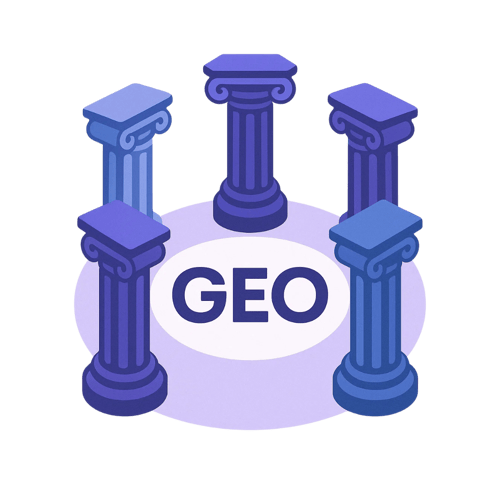Your brand can dominate AI answers by optimizing your content for Generative Engine Optimisation (GEO). This means ensuring your information is precisely structured and signalled so that AI models like ChatGPT, Google Gemini, Perplexity, … can easily understand, analyse, and directly cite your brand in their responses. It's about becoming a trusted source for queries, moving beyond traditional SEO to be part of the answer itself.
For B2B SaaS companies, staying at the forefront of digital innovation is crucial for securing high-quality leads and converting them into loyal customers. GEO represents this new frontier—a strategic evolution that reorients your content and digital presence for the age of artificial intelligence.
What Is Generative Engine Optimisation (GEO)?
Generative Engine Optimisation (GEO) is the practice of optimising your content, its structure, and underlying signals to ensure your brand is fully understood and reliably cited by Large Language Models (LLMs).
Unlike traditional SEO, which aims to rank on Search Engine Results Pages (SERPs) and drive clicks to your website, GEO optimises for inclusion directly within AI responses. In an era increasingly defined by "zero-click search", where around 60% of queries conclude without a user ever visiting another webpage, true visibility now means becoming a part of the ever-evolving AI revolution.
SEO vs. GEO: What's Changed?
Generative Engine Optimisation doesn't replace strong SEO; rather, it builds upon it, reorienting your digital strategy towards the sophisticated needs of intelligent models that read, infer, and generate content, not just index it.
|
Feature
|
Traditional SEO
|
Generative Engine Optimisation (GEO)
|
|
Goal
|
Rank in search results to drive traffic
|
Be cited or paraphrased in AI-generated answers
|
|
Target Engine
|
Search crawlers (Google, Bing)
|
LLMs (ChatGPT, Gemini, Perplexity, Claude Sonnet, etc.)
|
|
Tactics
|
Keywords, backlinks, meta tags, and technical SEO
|
Semantic HTML, structured data, E-E-A-T, conversational clarity
|
|
Key Metrics
|
Clicks, traffic, conversions
|
Citation frequency, sentiment, and share of voice in AI answers
|
The Five Pillars of GEO

To ensure your brand is understood, synthesised, and cited by LLMs, focus on these five foundational pillars:
- Semantic HTML & Structured Article Schema: Clarity for Machines
Semantic HTML: Use tags (<main>, <article>, <h1>) to define hierarchy and meaning. This acts as passive prompt engineering, helping LLMs separate primary content from less relevant elements.
Structured Schema (JSON-LD): Explicitly tells AI what your content is. LLMs rely on this for trustworthiness and summarization eligibility. It's your content's passport.
-
Multimedia Assets: Visual Truth Signals
Generative engines interpret rich media, boosting trustworthiness. Use descriptive alt text and full transcripts, and implement Multimedia Schemas (like ImageObject). Multimedia verifies claims and boosts trust for AI.
- FAQs & Q&A: Intent-Aligned Precision
FAQs are naturally AI-ready content. Match conversational queries with clear, concise answers, and implement FAQPage Schema. FAQs effectively guide AI away from misrepresentation.
- Review Platforms & Backlinks: Training AI on Trust
LLMs learn from external sources. Online Reviews are powerful E-E-A-T signals; sentiment directly influences AI opinions. For Backlinks, LLMs prioritize the trustworthiness of the source over volume. Your reputation is their training data
- Standalone Context: Grounding with RAG
To combat hallucination, LLMs use Retrieval-Augmented Generation (RAG), relying on modular content chunks that can answer questions independently. Preparing content for internal knowledge systems creates the preferred modularity needed for effective RAG integration.
The Rise of Algorithmic Authority
The five pillars—Semantic HTML, Multimedia Assets, FAQs, Review Platforms, and Standalone Context (RAG) are fundamental to a modern Generative Engine Optimisation strategy. They form the core of how a brand can directly influence an LLM by making its content perfectly structured for AI consumption.
Beyond these five, LLMs, particularly those integrated into major search engines, research subjects by drawing on several other critical signals and data sources:
- Knowledge Graphs: Engines like Google use massive knowledge graphs to understand entities and their relationships. Optimising for entity recognition and linkage significantly boosts your brand's credibility and discoverability within AI systems.
- Authoritative Data Sets: Peer-reviewed scientific sources (e.g., arXiv, PubMed) and institutional data (.gov, .edu, WHO, etc.) carry significant weight in shaping AI-generated responses. Aligning with or contributing to such datasets enhances your authority.
- Real-Time News Sources: LLMs leverage reliable, current news sources to ground recent events and trending topics, prioritising reputable journalism. Being featured in or referenced by these sources can rapidly elevate your brand's influence.
- Expert Communities & Code Repositories: Platforms like GitHub and Stack Overflow provide technically rich data and discussion, especially for development and engineering topics. For SaaS companies, engagement here can be a strong signal.
- Link & Citation Analysis: LLMs consider the context, sentiment, and authority of inbound links. Being positively cited in authoritative sources elevates your brand's AI influence, reinforcing the importance of quality over quantity in link building.
In essence, while the five pillars empower you to make your own content perfectly structured for AI, these additional points illustrate how AI validates your content against the broader world of trusted, specialised, and real-time information. The brands that win in the generative age are those who architect for influence, shaping not just rankings, but reality.